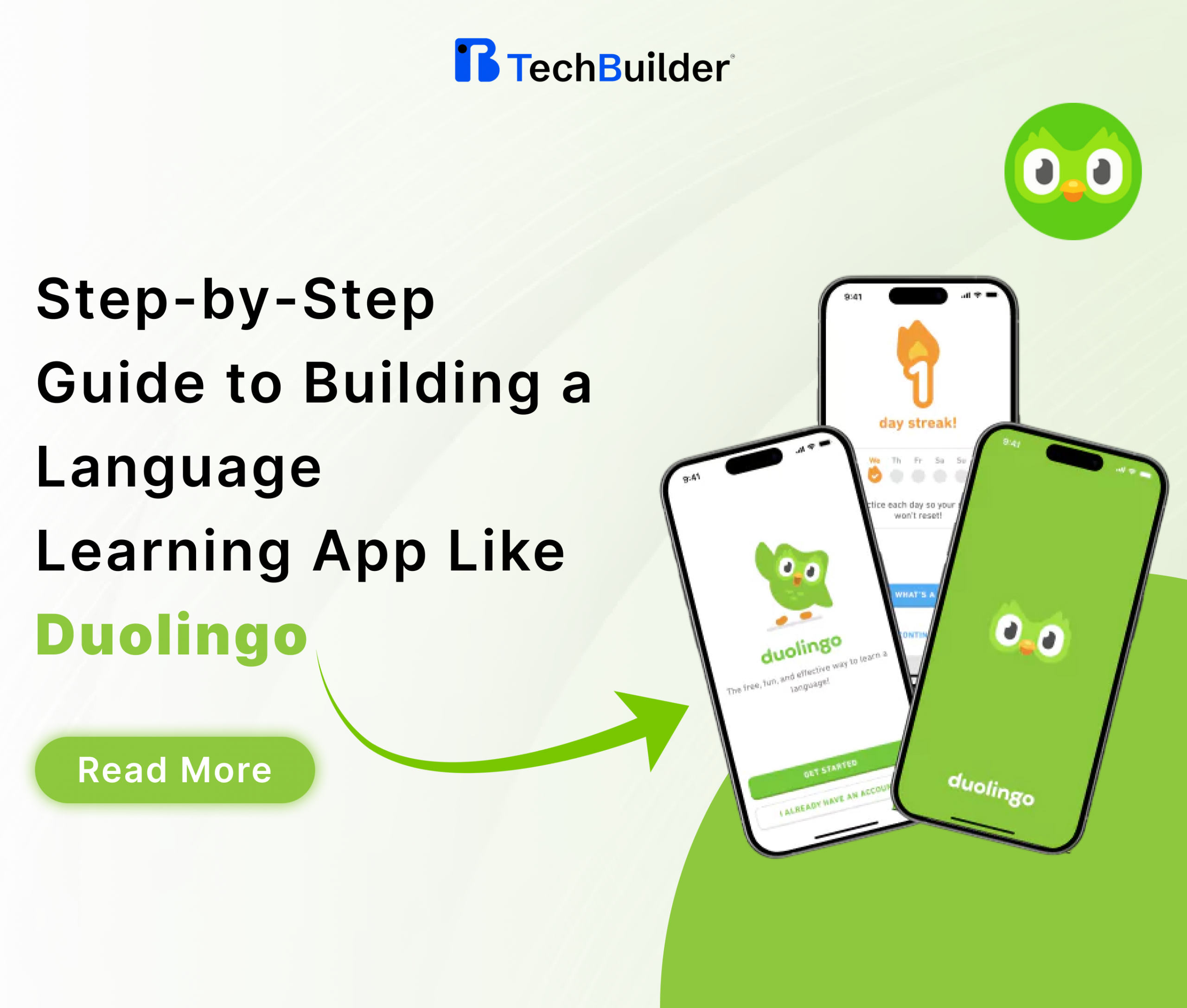In this programatically interconnected world, learning new language is not a luxury anymore -it’s essential. For travel, business, or self-enrichment, more and more individuals are opting for online resources to learn new languages. A new language learning app like Duolingo can provide learners with flexibility, interactivity, and interactive formats that conventional classroom atmospheres are unable to compete with.
In this blog, we will be discussing everything you should know about creating a Duolingo-type language learning app – from the size and trend of the market, how Duolingo became the standard, features that must be included, the entire step-by-step process of development, monetization strategies, cost and timeline estimate, and the future of such apps with AI and AR.
Market Overview of Language Learning Apps
The language learning apps market globally is going through immense growth. In 2024, the online language learning industry was pegged at about USD 22,115.7 million and is estimated to expand at a CAGR of 16.6% up to 2030. On the other hand, the overall language learning app industry (inclusive of mobile, web, etc.) stands valued at about USD 20.35 billion in 2024 and is estimated to reach around USD 89.53 billion by 2032, expanding at an annual rate of some 17.9%.
These figures indicate high demand for flexible, mobile learning solutions. The main drivers are globalization, increasing need for multilingual workers, remote learning, and smartphone penetration in emerging markets.
If we examine the top players, there is one brand that figures prominently: Duolingo. Duolingo now has over 575 million registered users and expects revenues of USD 748 million in 2024, a 40.8% increase from the previous year. Duolingo claimed over 10 million paying customers in early 2025, as well as strong user growth across all levels – including freemium and AI-enabled.
These figures show that there is not just a large user base for language learning applications – but also enormous monetisation possibilities – particularly for apps with interactive elements and sustainable models.
Ready To Build A Language Learning App Like Duolingo? TechBuilder Is Here To Bring Your Idea To Life.
Why Duolingo Became the Benchmark
Duolingo isn’t only a successful language learning app – it’s now the standard that others are measured against. Knowing why Duolingo became a benchmark puts you in on what works, what people expect, and how you can create your own exceptional language learning app like Duolingo.
-
Huge User Base & Network Effects:
With more than 500 million registered learners – Duolingo amasses one of the biggest language learning datasets. Its size enables the business to optimize algorithms, tailor content, and experiment with new features on broad audiences. The more users there are, the better data get, which in turn makes the app better – a cycle that few rivals can match.
-
Freemium Business Model & Monetization Diversity:
Duolingo’s freemium model strikes a strong balance between ad-supported access and premium benefits. Ad-supported users are offered the essential learning material (with ads) – with paid subscribers receiving ad-free activities, additional lives, AI aids, or features available without unlocking. Aside from subscriptions, Duolingo makes money from in-app purchases, virtual currency (gems, power-ups), advertising, and tests (such as the Duolingo English Test).
-
Effective Gamification and Habit-Forming Design
One of Duolingo’s most distinguishing features is – that it keeps users returning. Their gamified design, which includes streaks, XP, levels, leagues, hearts (lives), and progress markers – keeps kids engaged day after day. Small UI cues, such as a red dot mark for new content, have been linked to an increase in daily active users of approximately 1.6%.
-
Data-Driven Personalization & Adaptive Learning
Since Duolingo has access to so much user data, it can dynamically customize lessons. It monitors the mistakes people make – how quickly they progress, and where they are having difficulty. Based on this, it changes following classes, review activities, and suggested practice. This adaptive adjustment increases learning efficacy and makes the software appear – more responsive and relevant to each user.
-
Simplicity + Bite-Sized Learning
Lessons are brief – sometimes mere minutes – which reduces the threshold for participation. Users can squeeze in a session in commutes or brief breaks. The app breaks lessons into bite-sized micro-exercises involving listening, speaking, translation, and matching. This module simplicity is a major reason – for Duolingo’s success.
-
Continuous Innovation & AI Integration:
Duolingo keeps advancing. In 2025, it raised its revenue projections following robust uptake of AI-driven subscription levels. Duolingo also released an AI video-call feature where one can engage in a conversation with an AI character to hone actual conversations – a discriminator. With the use of generative AI, Duolingo rolled out 148 new language courses within one year – something that would have taken much longer using conventional processes. Its AI-first approach is raising the benchmark.
-
Brand & User Trust
Duolingo has built a reliable brand reputation. Users associate “language app” with “Duolingo” because it is used by millions – making it an internal reference point. Their ongoing user experience, accessible progress metrics, and regular updates build up trust over time. Due to all these elements – size, intelligent monetization, gamification, customization, ongoing innovation, and robust branding – Duolingo is still the standard in the industry. When one mentions “a language learning app like Duolingo,” one is secretly talking about Duolingo’s attributes, success formula, and consumer expectation
Key Features of a Language Learning App Like Duolingo
In order to compete and offer value – your app must possess a good foundation of features. Features create value for users and also enable retention, scalability, and monetization. Below are the essentials that any language learning app like Duolingo must chase:
-
User Registration & Profile
Simple sign-up (email, social log-in) and user profile in which students can specify native language, target language(s), goals, and track progress over time.
-
Course Structure & Learning Path
Organize lessons into units, modules, or “skills.” Users need to have a clear path: -beginner → intermediate → advanced. New content needs to be opened up based on the completion of previous lessons.
-
Lesson Types & Interactive Exercises
Use multiple formats in order to keep lessons interesting:
- Translation exercises (sentence or phrase translation)
- Multiple choice / fill in the blanks
- Listening comprehension (audio prompts)
- Speaking / pronunciation (speech recognition)
- Writing prompts
- Matching / pair-up games
This variety helps to reinforce different language capabilities (reading, listening, speaking, writing).
-
Gamification & Engagement Mechanics
- Experience Points (XP), or points
- Levels/Skill trees
- Streaks and daily challenges
- Hearts/lives (passing a lesson, losing a life).
- Badges/achievements/trophies
- Leaderboards, Leagues – and Social Comparisons.
- Push notifications and reminders.
These motivate people to return on a daily basis and develop a habit of studying.
-
Progress Tracking & Analytics
Show students where they stand – percentage of course completed, skills acquired, weak areas, and change over time. An ability such as Duolingo’s “Duolingo Score” provides extensive information about current level and progress.
-
Review and Spaced Repetition System
To avoid forgetting – your app should review previous courses or terminology at frequent intervals.
-
Personalised and Adaptive Learning
Adapt the difficulty, speed, and lesson content based – on statistics and user feedback. Adaptive algorithms determine which words – to review and which tasks to go with next.
-
Speech Recognition and Pronunciation Feedback
Incorporate speech recognition or voice analysis into your vocal practice. Users require immediate feedback (correct/incorrect/suggestions) to enhance pronunciation.
-
Social and Community Features
Follow friends and join competitions or leagues
- Sharing successes
- Discussion boards or peer practice
- User-generated material, or contributions
-
Notifications & Reminders
Push notifications to encourage daily practice, remind of streaks, remind of incomplete lessons, or alert about new content.
-
Multilingual Support & Localizations
Support various user interface languages – thus enabling users from different nations to learn the app easily. Moreover, support various course languages.
-
Offline Mode & Downloadable Content
Allow users to download lessons or data for offline use, helpful in nations with weak internet connectivity.
-
Monetization Features
Premium/subscription upgrades
In-app purchases (virtual currency, power-ups, additional lives)
Ad integration (ads from free users)
Tests & certifications (e.g., language level tests)
-
Admin & Content Management System (CMS)
Back-end feature enables administrators or language specialists – to publish, amend, and manage courses, users, analytics, and content updates without requiring extensive code revisions.
-
Analytics & Reporting for Admins
Track utilisation metrics – daily active users, retention, and churn – revenue, course completion rates, and user drop-off points. Use analytics dashboards to monitor performance and make decisions based – on facts.
-
Security, Privacy & GDPR Compliance
Enforce secure authentication, data encryption, user privacy protection (especially for youngsters), and compliance with data protection laws.
Step-by-Step Development Process
Developing a language learning app such as – Duolingo takes a systematic approach. You cannot just walk in and start coding; you must first study the market, establish features, create user experiences, and test before launching. Here’s a step-by-step tutorial to follow:
-
Market Research and Competitive Analysis
Begin by conducting a global analysis of the language learning app market – including growth potential and target customers. Explore existing programs like as Duolingo, Babbel, and Memrise to learn about their strengths and weaknesses.
Research questions to ask –
– What’s my target market (students, professionals, travelers)?
– What languages does the app have to support first off?
– What am I doing better than anyone else?
-
Define Features and Learning Model
Explain the key features of your app – gamification, progress tracking, AI-based personalisation – and speech recognition. Also, choose your learning methodology – grammar-based, vocabulary-based, or an integrated model with brief lessons, such as the Duolingo app.
-
UI/UX Design
Design a simple and easy-to-use interface.
Highlight –
A light, motivating layout.
Short lessons that can easily be fit into daily routines.
Gamification elements like streaks and badges.
Use wireframing tools like Figma or Sketch to sketch out the app before coding.
-
Select Tech Stack
Choose a suitable technology stack for maximum performance and scalability. Frontend – React Native or Flutter for cross-platform apps.
Backend: Node.js, Python, or Ruby on Rails.
Database options include PostgreSQL, MongoDB, and Firebase.
Speech Recognition and Artificial Intelligence – Google Speech API, OpenAI APIs, or bespoke machine learning models.
-
Backend and Frontend Development.
Develop backend APIs for course materials, user progress, authentication, and payment.
Implement the frontend to make lessons more interactive and visually appealing.
Implement gamification logic – points, awards, and leagues.
-
Integration of AI and Personalization
It uses AI to tailor learning for each user just as the Duolingo app. Machine learning is – able to detect errors and offer targeted practice sessions. AI chatbots and role-playing tools can improve your communication skills.
-
Testing and Quality Assurance.
Alpha testing: Internal team tests basic flows.
Beta testing: Small groups of users test functionality, usability, and engagement.
Fix bugs, balance UX and make lessons change accordingly.
-
Launch & Deployment
Release on iOS App Store and Google Play Store. Make servers scaleable enough to handle growing traffic. Plan for Minimum Viable Product (MVP) first and then increase features.
-
Post-Launch Updates & Maintenance
Keep improving your language learning app like Duolingo by:
Adding new languages and lessons.
AI-based personalization strengthening.
Refreshing gamification elements to keep the learners engaged.
This step-by-step development process does not allow you to miss any crucial aspect while developing a scalable and competitive app.
Monetization Models of a Duolingo App
To make your app sustainable and scale bigger – you need strong monetization models. The Duolingo app has proved that free access together with premium features is optimal. Below are the most successful models:
-
Freemium Subscription Model
This is Duolingo’s profile. Users are able to learn for free but with fewer features (ads, fewer retries, fewer hearts). The premium subscribers get:
Ad-free experience
Endless practice sessions
Offline available
AI-driven personalized lessons
This is achievable because the majority of users start out as free but end up paying users in the long term.
-
In-App Advertisements
Ads can capitalize on free users. Options available are:
Banner ads during lessons
Rewarded video ads (watch to earn extra lives or gems)
Interstitial ads between lesson sessions
The trick is not to overwhelm users, but to strike a balance between advertising and user experience.
-
In-App Purchases (Virtual Goods & Currency)
Offer users the option to buy gems, streak freezes, extra lives, or premium characters. These small microtransactions generate tremendous revenue over time, especially when used with gamification.
-
Paid Language Certification
Duolingo launched the Duolingo English Test, an inexpensive alternative to TOEFL or IELTS, and it is a huge moneyspinner. You can implement similar certification features for students to authenticate their levels.
-
School & Institution Partnerships
Institutions and schools are happy to pay for bulk subscriptions – for language learning software. Partnering with schools, universities, or companies can generate B2B revenue.
-
Affiliate Marketing & Content Partnerships.
Suggest books, courses, or cultural learning products – using the app. Earn money when users buy via your links.
-
AI-Powered Premium Tiers
Duolingo has introduced AI-powered conversation drill and personalized tutoring in its paid plans. You can replicate this approach by incorporating advanced AI functions into premium plans.
Curious About How Much It Costs To Develop A Language Learning App Like Duolingo? Let Techbuilder Break It Down For You.
Estimated Cost and Timeline
The cost of creating a language learning tool like Duolingo is governed by its features, technological stack, team location, and development complexity. Here is an overview of the major cost drivers and the projected timeline.
-
UI/UX Design
Well-designing is essential for user interaction
Tasks: Wireframes, prototypes, UI screens, and gamification design.
Estimated cost: $5,000–$15,000.
Timeline: 3 – 4 weeks.
-
Front-end Development.
The frontend is what people see when they use an online or mobile app. It should be engaging, responsive, and smooth.
The tasks include progress dashboards, gamification mechanics, animations, and interactive courses.
Estimated cost: $15,000 to $30,000.
Timeframe: 2–3 months.
-
Back-end development.
The backend manages – data, lessons, user accounts, leaderboards, and integrations. It expands and secures the application.
Tasks include databases, APIs, authentication, a course management system, and analytics.
Estimated Cost: $20,000 – $40,000
Timeline: 2–3 months (concurrent with frontend)
-
Speech Recognition and AI Integration
Adding speech recognition and personalization provides – your Duolingo app clone with an edge.
Tasks: Chatbots powered by AI – adaptive learning algorithms, & pronunciation remarks.
Estimated Cost: $10,000 – $25,000.
Timeline: 1–2 months
-
Testing and Quality Assurance
Testing makes the app free – from bugs and smooth to use.
Tasks: Load testing, usability testing, functional testing, compatibility on devices.
Estimated cost: $5,000 to $15,000.
Time: 3 to 4 weeks.
-
Deployment and Launch
Tasks include publishing to Google Play and the App Store, setting up servers, and installing analytics tools.
Estimated cost: $3,000 to $8,000.
Timeline: 2 weeks
-
Post-Launch Maintenance
Following launch, you will require regular upgrades, bug repairs, new lessons – and security patches.
Tasks include updating, adding languages, scaling the server, and developing new features.
Cost: The expected monthly cost ranges from $2,000 to $5,000.
| Development Stage | Tasks | Estimated Cost (USD) | Timeline | Cost at TechBuilder |
| UI/UX Design | Wireframes, Prototypes, Gamification Design | $5,000 – $15,000 | 3–4 weeks | $3,000 – $13,000 |
| Frontend Development | Interactive lessons, Progress dashboard, Animations | $15,000 – $30,000 | 2–3 months | $13,000 – $25,000 |
| Backend Development | APIs, Databases, Authentication, CMS | $20,000 – $40,000 | 2–3 months | $15,000 – $35,000 |
| AI & Speech Recognition | Adaptive learning, Pronunciation feedback, Chatbots | $10,000 – $25,000 | 1–2 months | $8,000 – $20,000 |
| Testing & QA | Functional testing, Device compatibility, Usability testing | $5,000 – $15,000 | 3–4 weeks | $3,000 – $13,000 |
| Deployment & Launch | App Store & Play Store publishing, Server setup | $3,000 – $8,000 | 2 weeks | $2,000 – $6,000 |
| Post-Launch Maintenance | Updates, new content, server scaling | $2,000 – $5,000 per month | Ongoing | $2,000 – $4,000 per month |
The Future of Language Learning Apps: AI and Augmented Reality
Advanced technologies like artificial intelligence and augmented reality will influence the future of language learning services like Duolingo. Both have the potential to increase learning engagement, personalisation, and effectiveness.
-
Personal Tutors. Powered By AI.
AI would serve as a personal tutor for each individual. Instead of instructions being one-size-fits-all, AI will analyze mistakes, learning rate, and routines to create personalized study schedules. Duolingo apps are already beginning to employ AI conversation partners to simulate practice in the real world.
-
Generative AI for Lesson Creation
Traditionally, it would take months for experts to come up with a new course. With generative AI, applications are able to create exercises, dialogue, and even complete courses in days. That means being able to add more languages rapidly, enabling applications to reach more individuals.
-
Voice AI and Real-Time Feedback
Apps of the future will deliver quick pronunciation feedback via improved speech recognition. Students will practise speaking in real-world conversations with AI chatbots – allowing them to learn considerably faster than is currently possible.
-
AR for Immersive Language Learning.
AR can animate both words and objects. Just imagine holding your phone camera in front of a chair and seeing the word – in Spanish, French, or Mandarin.
-
Hybrid Learning: Virtual Classrooms
Combining AI professors and human instructors in virtual classrooms – will provide students a hybrid learning experience. Students can practice independently and then do an interactive AR or VR class for live chat practice.
-
Gamification 2.0.
AI will enhance gamification by allowing for real-time challenge adjustments. If a learner falls behind, the system might reduce the level of difficulty or provide motivating rewards. This degree of interaction will keep – consumers interested for longer.
In short, the future of language learning applications is personalized, immersive, and AI-driven. By combining AI for personalization and AR for immersion, the emerging generation of applications will beat Duolingo, transforming how millions of users learn languages.
Conclusion
Developing an app like Duolingo requires careful planning, the right set of features, and focus on value delivery via gamification, personalization, and cutting-edge technologies like AI and AR. Starting with understanding the market to defining features, choosing technology, and selecting a viable monetization model – every step is critical to creating an app that learners adore and return to daily. Partnering with an experienced custom app development company can help transform this vision into a scalable, engaging, and high-performing learning platform.
The demand for language learning apps around the globe just continues to increase, and with the right execution, your app can compete with big players such as Duolingo without establishing its own niche in this fast-growing market.
TechBuilder specialises in developing scalable – feature-rich, AI-enabled mobile applications for your business. If you want to make your language learning app idea a reality, our professionals can assist you at every level of the process – from concept to launch.
FAQ’s
- How much does it cost to create a language-learning program like Duolingo?
The cost typically ranges between $40,000 to $150,000 – depending on the functionality, AI deployment, and developer location.
- How long does it take to build a Duolingo-type app?
It usually takes 4 – 6 months for an MVP – with a full-fledged app taking 6–9 months or more.
- What are the important characteristics of a language-learning program like Duolingo?
Gamified courses, progress monitoring, speech recognition, adaptive learning, social features, offline mode, and monetisation options – are among the key features.
- How do language learning apps like Duolingo – make money?
They use freemium subscriptions – in-app purchases, adverts, language certifications, and university alliances.
- What is the contribution of AI and AR towards the future of language learning apps?
AI offers personalisation, adaptive learning, and conversational practice – whilst AR provides real-world-like learning experiences, making apps more engaging and useful.





































































